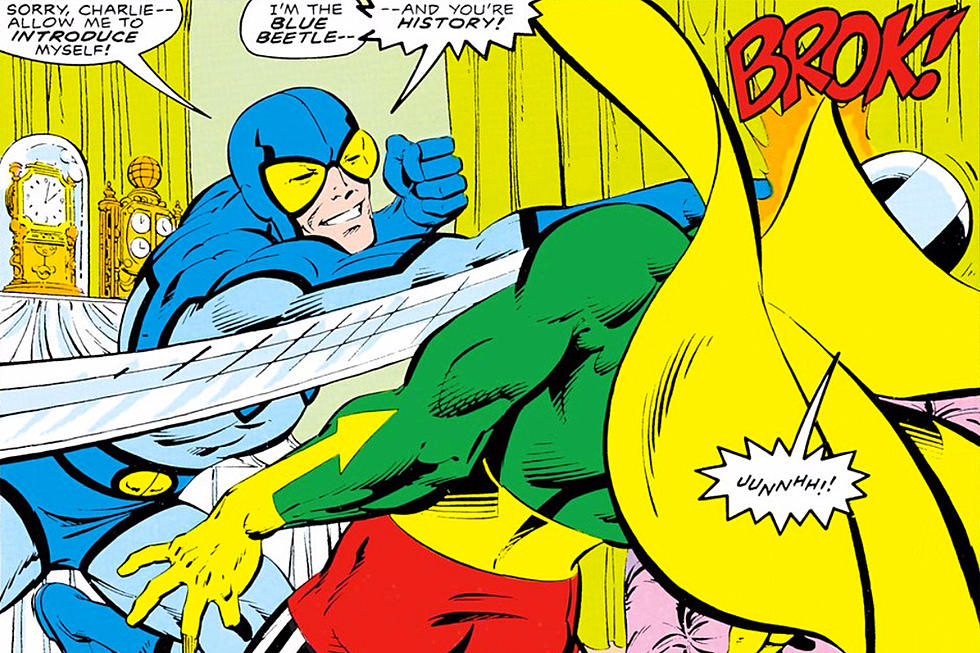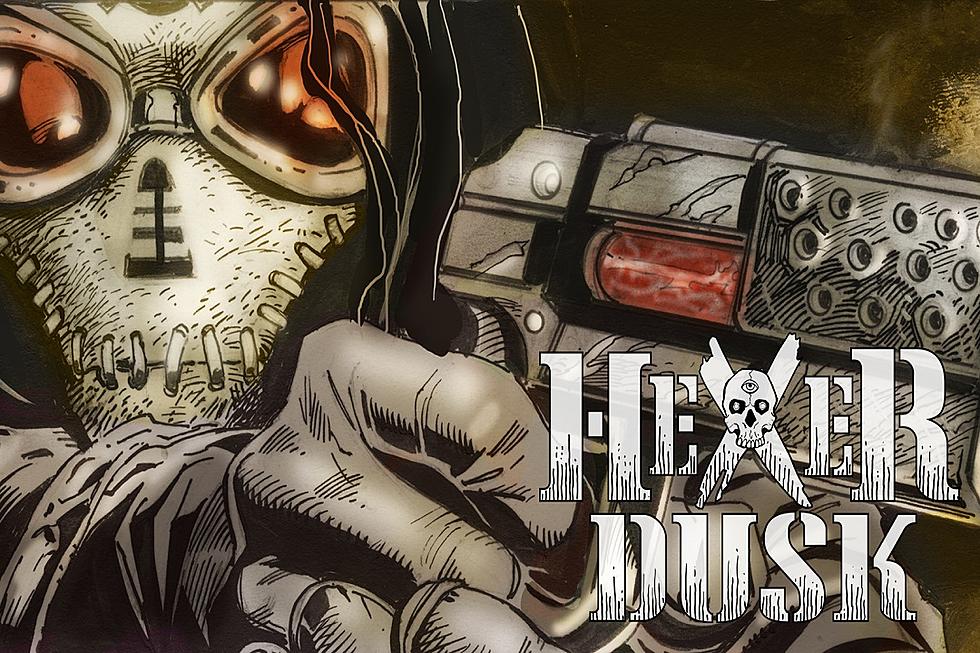
Ask Chris #213: A Brief History Of The Wrath Of God
Q: Just re-read Gotham Central and it got me wondering, what's the deal with the Spectre? -- @BatIssues
A: The deal? Son, the deal is that he was on what is quite possibly the single most metal comic book cover of all time.

Good God almighty, just look at that thing. An entire city is in flames and the flames are rising up over the skyscrapers and forming dinosaurs, and the Spectre, whose legs are also made of fire, is riding the dinosaurs and staring at the reader like he's daring you to just try reading that comic to see if there is any possible way that could actually happen in the story -- which, incidentally, it doesn't. Still, that cover... I seriously just showed that thing to a baby and by the time I got back from putting it away in my long boxes, that baby was playing drums for Slayer. True story.
I would honestly be willing to say that that piece by Joe DeVito, who provided painted covers for most of John Ostrander and Tom Mandrake's The Spectre run from 1992 to 1998, is quite literally the high point of the Spectre's 74-year existence. Once you get past that, though, he's still a pretty interesting character, althoguh it's less because of anything that's actually happened in the comics than because of how much he doesn't really work, and the question of whether a character can actually be too big for superhero comics.
The Spectre was originally created in 1940 by Jerry Siegel and Bernard Baily, but it's worth noting that some sources -- including legendary editor Roy Thomas, who's about as big a fan of DC's Golden Age titles as you're likely to find -- give Siegel full credit for the whole concept, and that's the first interesting point. After all, Siegel is, as you may have heard, the co-creator of arguably the most enduring and significant character in comics history, who's known for his incredible physical strength: Slam Bradley.
Oh, and also Superman, I guess.
So right away, we have a contrast. What's really interesting to me is that while Superman would eventually grow into a character who'd be defined by his almost limitless power in the '50s and '60s -- a time when Siegel was still very much a part of telling those stories -- he definitely wasn't on that level in 1940. He could leap a tall building, but he couldn't fly over it; he could lift a car, but not a planet; he was bulletproof but an artillery shell would knock him out. Don't get me wrong, it was all functionally the same and created a character who was unquestionably the most powerful person in the world, but there were limits, even if they didn't last.
The Spectre never really had those limits. In his first appearance, we get a pretty simple origin story: Jim Corrigan is a cop who gets murdered, but finds himself charged by God Himself with a mission to fight crime until there is no more crime.
I realize that the never-ending battle against crime is a pretty standard part of most superhero origins, but Siegel and Baily make it seem like a terrifying punishment, especially since they show Corrigan pleading for eternal peace before being cast back down to a fallen world to battle the worst that humanity has to offer forever. If you look at it with any kind of realism -- and I admittedly hate doing that in most if not all cases -- then that's terrible. Batman might be fighting crime for his entire life, but that's what, sixty years? And if he manages to clean up a single city, then he can rest easy with a job well done. The Spectre has a mandate from the Almighty to stay on Earth fighting crime until "all vestiges of it are gone." We have had crime for the entirety of human history, and I don't want to bum anybody out here, but it's looking pretty likely that we're going to have it for a while yet. That's the reality that Jim Corrigan is faced with eight pages into his existence, and the first thing that happens once he gets back to Earth is that he sees his own dead body and realizes that this is actually happening. That's harrowing.
It does, however, provide us with one of my favorite single panels of all time:
That "Abruptly" interstitial is what cracks me up every time.
Point being, right from the start, there's an idea of horror that's sitting at the heart of the Spectre. It's literally a ghost story, but it's a ghost story that's filtered through this lens of the brand new genre of superheroes that Siegel had just helped to create, and it makes for a weird marriage of ideas. The end result is something that, for good or ill, could not be more of a Golden Age Superhero: A big dude in trunks and a cape and no other clothing with powers that are ill-defined at best.
What happens next, at least as I see it, is that the Spectre becomes an unintentional casualty of the Comics Code. It's always worth noting that the Code was never a governmental instution meant to actually regulate the content of comics, but a weird little bit of self-policing that was mostly geared at tanking EC's wildly popular horror comics and allowing superheroes to flourish. And since EC's big trick was the gruesome, ironic punishment that had also been the Spectre's stock in trade since day one...
...he was kind of left by the wayside. By that point, though, it was almost a moot point. The dust of that original rush to capitalize on the brand new medium of American comic books had long since settled, and Superman, Batman and Wonder Woman were pretty much cemented at the top of the heap.
Because of that, nothing really happens with the Spectre for a long, long time. He shows up alongside the Justice Society in the annual team-ups, but it's a weird fit for a dead man on a holy crusade who has the power to shrivel people into skeletons and turn them into pencils that get shoved into giant sharpeners to be sititng there next to a guy who runs fast and some dork with wings. It's only in solo stories that he really starts to come back as his own distinct character, when you get those beautiful Jim Aparo stories.
By that time, it's 1974, and while the Comics Code would keep their stamp on the covers for the next thirty years, their stranglehold on comics publishing was already starting to wither into irrelevance, at least where the supernatural was concerned. You had your Tomb of Dracula and your Werewolf By Night over at Marvel, and since DC's nominal "horror" titles had managed to survive on the strength of covers where things that were not usually skeletons were revealed to actually be skeletons, I imagine that bringing back the Spectre to mete out some horrifically violent punishments seemed like a pretty good idea.
And they were violent, especially by the standards of the time. In Fleisher and Aparo's run in Adventure Comics, the Spectre would turn crooks to glass and shatter them or melt them like giant candles:
There are great visuals in that run -- probably why it became one of the famous Baxter Paper Reprints a decade later -- but it only lasts about a year, and I don't really know why. My guess would be that it was just the nature of the beast for Adventure, which had rotated through a cast of different characters like Black Orchid and Supergirl ever since the Legion of Super-Heroes had been carted off to their own mag, but I'd also believe that a pale ghost showing up to complain about how he was being denied the glory of heaven while chopping people in half with giant scissors may have been a little grim for a comic that would replace The Spectre with a comic where Aquaman rode around on a dolphin and fought a villain named "The Fisherman."
So once again, he bounces around, making a very notable appearance in Crisis on Infinite Earths in a form that puts the focus on his unfathomable power. This is the story where he's physically separating two different Earths annd reachig back to grab the entire universe with a single hand -- powers that are in scale with what was going on in that comic. And from that extremely memorable appearance, you get a few other shots at stories, including those Baxter reprints of the Aparo stuff, but it's not until 1992 that he lands an ongoing, and this -- this -- is where things get interesting.
The team assigned to bring you the updated Spectre was John Ostrander and Tom Mandrake, who had previously collaborated for DC on Firestorm, and they ended up staying on the book for six years of pretty awesome stories. They're the ones who made the biggest mark on the Spectre, and they did it by keeping the viciously brutal ironic punishments of the Fleisher/Aparo stories, but taking the nature of the character to its logical extreme.
Under Ostrander and Mandrake, the idea of the Spectre as a punishment, as a curse that would keep you out of Heaven, was made a driving force. Their version of Jim Corrigan was a corrupt cop who was sentenced to be the host of the Spectre, who was himself sentenced to the role of meting out God's wrath for his part in Lucifer's rebellion. The punishments for murderers had the same horrific irony, like when he took out a bunch of drug dealers by turning them into his fingers and injecting fire into his arm like heroin...
...but they were taken to a new scale that showed the Spectre's powers to be limitless. There's an infamous issue where he intervenes in a civil war by destroying an entire country and killing everyone in it except for the two people leading the opposing factions, leaving them to fight over a ruined landscape littered with corpses.
What really surprises me about all this is that the book never took the path that Swamp Thing, Animal Man and Sandman did to become a Vertigo book. It remains firmly rooted in the DC Universe, to the point where that country that gets destroyed is Vlatava, the home of Count Vertigo. Ostrander had already proven with Suicide Squad, featuring Count Veritgo, that he was capable of blending in disparate parts of a fractured universe into a cohesive whole. But keeping the Spectre in the core DC Universe with powers on that scale raises a lot of questions about what he's doing -- and what he's not doing. Why doesn't he just show up and turn Lex Luthor into a piece of Kryptonite and shatter it into a million pieces? How come the Joker, who I am pretty sure has a bigger body count than Count Vertigo, was never found turned into a balloon and then popped in his cell at Arkham Asylum? And for that matter, how come Superman never tried to put the Spectre in jail for literally killing an entire country?
The answer is, of course, that it's comics and the Spectre can't just pop in and vaporize someone else's villains because that's not a good story, but that's the fact that we all ignore because that's the only way superhero comics work. Having a character like the Spectre just makes that a whole lot harder to do.
There is a whole lot of neat stuff added into the mythos of the character, though. I'm particualrly fond of the bit where you find out that the Spectre was imprisoned in Limbo between 1 AD and 33 AD, because vengeance and forgiveness can't walk the Earth at the same time.
Ostrander and Mandrake's run on The Spectre ends after 62 issues in early 1998 -- which is a huge bummer, because six months later we would've gotten a tie-in to DC 1,000,000 that would've been all about the Wrath of God tearing up the 853rd Century, which would have been amazing -- and they leave the book by finally giving Corrigan his peace and separating him from the Spectre. But that, of course, leaves the embodiment of divine vengance without its human host.
And so they bolt it onto Hal Jordan.
This is... I mean, this is not a great idea. I talked at length about the problematic treatment of Hal Jordan as a character once he was shuffled out of the role of Green Lantern, and making him the Spectre is a huge part of that. There are ideas in play that I understand -- Hal working off his murders of the Green Lantern Corps in order to redeem his character, something that was ultimately done in a much more hamfisted way by attributing it to a giant yellow space-bug -- and there are bits of it that I like in theory -- a character defined by his indomitable willpower being tasked with wrangling the actual Wrath of God -- but it was never going to work. Anything that Hal became was always going to be overshadowed by his identity at Green Lantern, something that wasn't really helped by the design that was basically just Hal's Green Lantern uniform with a hood. Even in a universe that was still trying to define itself by legacy, this was transitional at best, and generally just showed that we were never really going to move on from Hal Jordan, a character who had never really left.
Weird as it is for me to say it as a huge fan of both Gotham Central and Final Crisis, Cris Allen's time as the Spectre is actually the least memorable of the bunch, but I attribute that less to what actually happened in the stories than to it just not lasting very long before everything got chucked out for the New 52.
In the end, though, I imagine that without some retooling, you'd just run into the same problems. Everyone knows about the frequent complaints about characters like Superman or Dr. Strange, that they're just too powerful to be interesting, and in those cases, I don't think you have a leg to stand on. With the Spectre, though, you're dealing with something that goes beyond just casting spells, you have actual omnipotence and a mandate to end all crime, and that's pretty difficult to write your way around. It's addressing the small-scale morality of comic books by projecting it onto the largest scale possible. It's like cutting a birthday cake with a shotgun. It might make for a fun party, but it's kind of a lousy dessert.
Ask Chris art by Erica Henderson. If you’ve got a question you’d like to see Chris tackle in a future column, just send it to @theisb on Twitter with the hashtag #AskChris.
More From ComicsAlliance


![Bizarro Back Issues: Beware The Dragon God! (Oh Don’t Worry, It’s An Octopus) (1981) [Fantasy Week]](http://townsquare.media/site/622/files/2016/10/Spectre01.jpg?w=980&q=75)

![A Break From The Usual Skullduggery: John Ostrander On ‘Suicide Squad: War Crimes’ [Interview]](http://townsquare.media/site/622/files/2016/08/Ostrander00.jpg?w=980&q=75)



![The Spectre Is About To Get Loose In ‘Gotham By Midnight’ #10 [Preview]](http://townsquare.media/site/622/files/2015/10/GBM00.jpg?w=980&q=75)
